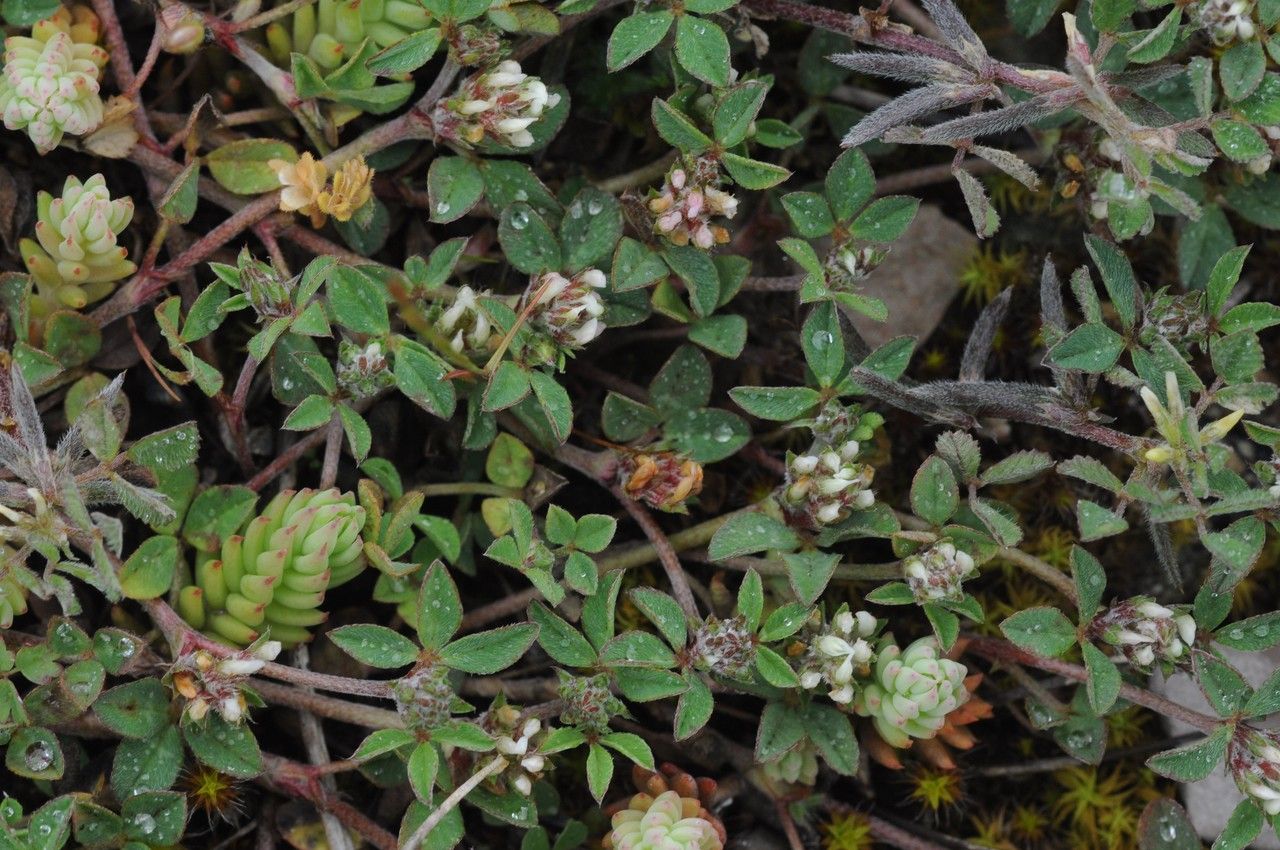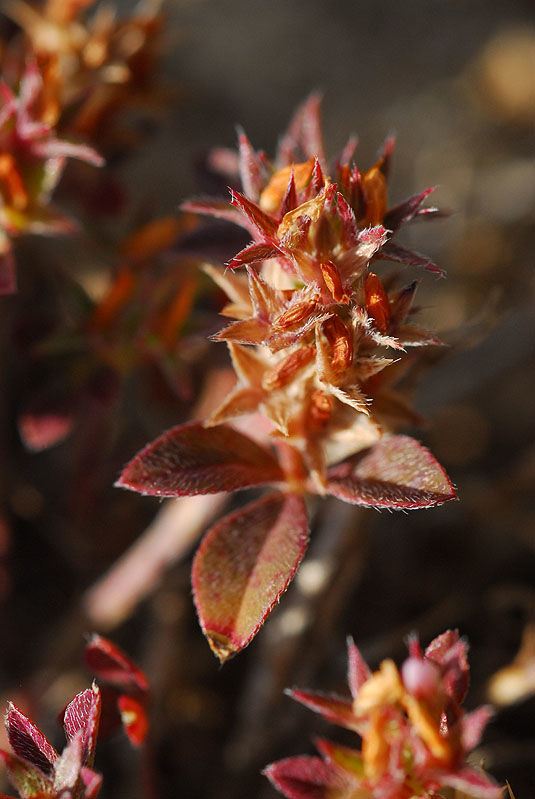Hairy Clover
trifolium scabrum
Also known as: ["Hairy Clover","Scabrous Clover"]
Overview
A small, annual clover species with hairy leaves and small, spherical flower heads.
Benefits & Perks
["wildlife attractant (bees, butterflies, birds)","low maintenance"]
Botanical Classification
| Phylum: | Magnoliophyta |
| Class: | Magnoliopsida |
| Order: | Fabales |
| Family: | Fabaceae |
| Genus: | Trifolium |
| Botanical Name: | Trifolium scabrum |
Plant Characteristics
Basic Information
- Category: Flowers
- Suitable Location: garden bed or container in a location with good air circulation
- Suitable For:
- Is Weed: No
- Allergenicity: low
Environmental Needs
- Climate: {"temperatureRange":"5–30°C"}
- Hardiness: {"zones":"7–10"}
- Misting: rarely required, only if ambient humidity is very low
- Drainage: Fast-draining to prevent waterlogging.
- Soil Type: Well-draining, loamy soil with organic matter; can tolerate poor soils.
Maintenance Level
- Maintenance Level: low
- Toughness Level: moderate
- Pruning Frequency: Light pruning every 2–3 months; major pruning annually after flowering.
- Pruning Intensity: Moderate; remove up to one-third of growth for major pruning.
Care Details
Ideal Sunlight Coverage:
Full sun to partial shade; 6–8 hours of direct sunlight per day, with some afternoon shade in hot climates.
Sunlight Tolerance Tips:
Acclimate plants gradually to intense sunlight; protect from harsh midday sun; adjust placement based on seasonal light changes.
Care Requirements
Care Difficulty
easymoderate
Sunlight
full sun to partial shade
Rotate plant for even light exposure; use shade cloth in extreme heat; monitor for sunburn.
Watering
every 7–10 days during active growth, reduce in winter
Water thoroughly but infrequently; ensure soil dries between waterings; avoid overwatering.
Soil
well-draining, loamy soil with moderate organic content
pH: Slightly acidic to neutral, pH 6.0–7.0.
Use a mix of potting soil and perlite; avoid heavy clay soils; check drainage before planting.
Temperature
Prefers moderate temperatures, 60–75°F (15–24°C); tolerates cooler conditions but not frost.
Avoid sudden temperature changes; protect from drafts; maintain consistent warmth.
Fertilizing
every 4–6 weeks during spring and summer
Apply fertilizer to moist soil; flush soil occasionally to prevent salt buildup; reduce frequency in dormant periods.
Propagation
Methods
Stem cuttings or division; stem cuttings are more common for home growers.
Step-by-Step Propagation Guide
- Take a 4–6 inch cutting.
- Remove lower leaves.
- Dip in rooting hormone.
- Plant in medium.
- Keep moist.
Best Time: Spring or early summer when the plant is actively growing.
Environment
Warm, humid environment with indirect light; maintain consistent moisture.
Medium
Well-draining potting mix with perlite or sand; can also use water propagation for cuttings.
Hormone
Rooting hormone is optional but recommended for faster root development.
Timeline
Roots may develop in 2–4 weeks; new growth may take 6–8 weeks.
Tools Needed
Pruning shears, rooting hormone, small pots, well-draining medium.
Quick Tips
Use clean tools to prevent disease; maintain humidity with a plastic bag; avoid direct sunlight.
Pruning & Repotting
Pruning Guide
Method
Pinch back tips for bushier growth; cut just above a leaf node or bud.
Pruning Plan
Prune to maintain shape, encourage bushier growth, and remove dead or diseased parts.
Tools
Pruning shears, sterilizing solution, gloves.
Checklist
Sterilize tools; prune dead or yellowing leaves; shape the plant; clean up debris.
Repotting Guide
Best Season
Spring, before the active growing season begins.
Pot Size
Increase pot size by 1–2 inches in diameter; ensure good drainage.
Method
Remove plant gently; trim roots if necessary; place in a new pot with fresh soil; water lightly.
Suggestions
Repot every 2–3 years or when roots fill the pot; beneficial for growth and soil freshness.
Checklist
Choose appropriate pot; prepare new soil; handle roots carefully; water after repotting.
Advanced Care Tips
Watering Mastery
Watering Checklist
Check soil moisture; water deeply; ensure drainage; avoid wetting leaves.
How to Apply Water Properly
Water at the base of the plant, ensuring moisture reaches the root zone; allow excess water to drain; water in the morning to reduce evaporation.
Watering Schedule Tips
Water deeply once the top inch of soil is dry; reduce frequency in winter to prevent root rot.
Soil Improvement
Add perlite or sand for drainage; incorporate compost for fertility; ensure good aeration.
Temperature Stress Management
Signs of Temperature Issues
Wilting, leaf discoloration, or stunted growth in extreme heat or cold.
Cold Stress
Slows growth and may cause leaf drop; prolonged cold can damage roots.
Solution: Move to a warmer location; use a heat mat for seedlings; protect with mulch.
Hot Stress
Leaves may scorch, wilt, or drop; flowering may be reduced.
Solution: Provide shade during peak heat; increase watering; use mulch to retain soil moisture.
Fertilizing Guide
Fertilizing Checklist
Check fertilizer label; dilute properly; apply during active growth; avoid contact with leaves.
Fertilizing Method
Use a balanced, water-soluble fertilizer diluted to half strength; fertilize every 4–6 weeks during growing season; avoid fertilizing in winter.
Common Problems & Solutions
Toxicity Warning
Cats
Non-toxicTrifolium scabrum is not considered toxic to cats. It poses no significant risk if ingested or handled by felines.
⚡ Toxic If:
Generally non-toxic
Dogs
Non-toxicTrifolium scabrum is not considered toxic to dogs. It poses no significant risk if ingested or handled by canines.
⚡ Toxic If:
Generally non-toxic
Humans
Non-toxicTrifolium scabrum is not considered toxic to humans under normal circumstances. It is a species of clover that is generally safe for consumption or handling.
⚡ Toxic If:
Generally non-toxic
Frequently Asked Questions
Q: Is Trifolium scabrum toxic to pets?
A: No, it is non-toxic to dogs and cats.
Q: What are the common uses of Hairy Clover?
A: It is primarily used as forage for livestock and as a soil nitrogen fixer.
Q: How does Trifolium scabrum attract wildlife?
A: Its flowers are attractive to bees and other pollinators.
Quick Reference
| Family: | Fabaceae |
| Care: | easy |
| Light: | full sun to partial shade |
| Water: | every 7–10 days during activ |
Get Expert Care Tips
Download the Plantious app for personalized care reminders and plant identification!
Google Play App Store








